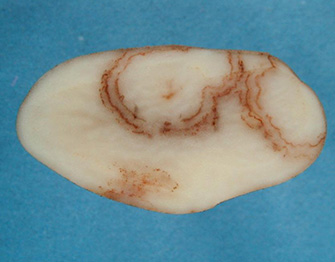Symptoms
The initial or primary infection does not give rise to foliar symptoms. Dark arcs and rings may be visible on the tuber skin. Rings may encircle the whole tuber and can be concentric, sometimes breaking the surface. Internal spraing might be present as brown arcs and flecks especially after a sudden or prolonged temperature drop.
Secondary symptoms, on a plant developing from an infected tuber, can show yellow spots or patches on lower leaves and yellow or pale green V shapes on upper leaflets especially under cooler conditions. Plants may be stunted with closely bunched upper leaves with wavy or rolled margins (hence mop top). Tubers can be distorted, cracked and show russetted, net like surface patches.
Tuber internal flecking caused by spraing is often mistaken for internal rust spot.
Transmission
The virus is transmitted by the fungus Spongospora subterranea in which it is likely to persistent for many years within cystosori (spore balls). PMTV cystosori can survive in soil for many years without potato crops.
Infection of roots and tubers by the virus is favoured by conditions favourable to the fungus, particularly wet soil. The disease is mainly spread on seed in infected powdery scabs.
Control
Generally any control measure against powdery scab will also help to control PMTV e.g. using resistant varieties, long rotations, clean seed on clean land and promoting good drainage. In the absence of the vector, transmission from mother to daughter tubers is, depending on variety and conditions, incomplete, and so is self eliminating. Together with roguing of symptomatic plants the infection can be eliminated from stocks in a few generations.
Infection is also discontinuous within the plant making diagnostics problematic and testing of symptomatic plants may return a false negative result. Field testing for the virus is commercially available.
